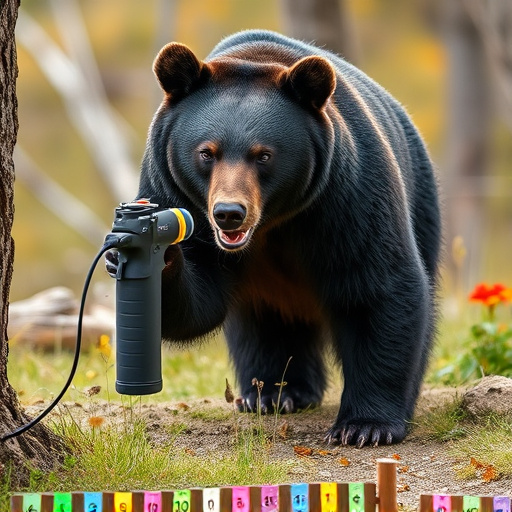Bear spray, like Guard Alaska, is an essential tool for safe exploration in bear-inhabited areas, using capsaicin from chili peppers in its aerosol formula. Effective usage involves aiming towards the bear's face and body to create a protective barrier, but improper use can lead to environmental impact as residue may affect non-target species such as birds, small mammals, and insects. To minimize risks, campers should follow safety measures including proper food storage, elevated containers, avoiding cooking near sleep areas, staying loud while moving, and regular checks for bear spray residue. These proactive steps, combined with understanding wildlife behavior, ensure a safer trip for both campers and bears.
- Understanding Bear Spray: What It Is and How It Works
- The Impact of Bear Spray Residue on Wildlife
- Safe Handling and Application Techniques for Maximum Effectiveness
- Choosing the Right Bear Spray for Your Camping Needs
- Beyond Spray: Additional Safety Measures for Camping in Bear Country
Understanding Bear Spray: What It Is and How It Works
Bear spray, also known as bear repellent, is a crucial tool for anyone venturing into bear country. It’s designed to deter and repel aggressive bears when used correctly. When you’re camping in areas with wild bears, understanding how bear spray works is essential for your safety.
Bear spray is a specialized aerosol that contains capsaicin, the active ingredient found in chili peppers. When sprayed towards a bear, it irritates the bear’s eyes, nose, and respiratory system, temporarily disorienting and encouraging the bear to leave the area. The key to its effectiveness lies in the fine mist particles, which ensure a wide area of coverage and rapid evaporation of the spray residue, minimizing any potential wildlife impact. Proper usage involves aiming for the bear’s face and body, creating a barrier of spray that allows you to retreat or stay safe until the bear departs.
The Impact of Bear Spray Residue on Wildlife
The effectiveness of bear spray, like Guard Alaska, relies heavily on proper usage and understanding its impact on wildlife. While it’s designed to deter bears by irritating their eyes and nostrils, bear spray residue can have long-lasting effects on the environment. After a bear encounter, even if the spray is used successfully, remnants of the chemical can remain in the area, potentially affecting non-target species.
Studies show that bear spray residue can persist on plants, rocks, and other surfaces for extended periods, leading to secondary exposure for animals like birds, small mammals, and insects. This can cause unintended harm, with symptoms ranging from respiratory distress to behavioral changes. As such, responsible usage includes aiming carefully at the bear’s face and avoiding wind-blown spray that could reach other wildlife or sensitive ecosystems.
Safe Handling and Application Techniques for Maximum Effectiveness
When handling Guard Alaska bear spray, proper technique is key for maximizing its effectiveness in the event of a wildlife encounter. Always inspect the can before use to ensure there are no defects or damage. Check the expiration date and make sure the seal is intact. When ready to deploy, aim low—at the base of the animal’s neck or chest—to ensure the spray reaches the sensitive eyes, nose, and mouth areas first. A quick burst of 2-3 seconds is usually sufficient. Avoid spraying in the wind, as Bear Spray Residue can drift back onto you or your surroundings, potentially causing irritation or even impacting nearby wildlife.
For best results, practice your application technique regularly. Understand that once triggered, there’s no turning back, so use it only as a last resort. Remember, the spray isn’t just for bears; it can also deter other aggressive wildlife like cougars and coyotes. Be mindful that improper use or misuse could have negative impacts on wildlife, so always follow instructions carefully. In case of accidental spraying, ensure everyone moves away from the spray cloud to avoid inhalation irritation.
Choosing the Right Bear Spray for Your Camping Needs
Beyond Spray: Additional Safety Measures for Camping in Bear Country
When venturing into bear country, using bear spray like Guard Alaska is a crucial defense mechanism. However, beyond the spray, there are additional safety measures campers should take to minimize risks and ensure a safe trip. Understanding wildlife behavior and taking proactive steps can significantly reduce potential encounters.
One key aspect is to be mindful of food storage. Always keep food sealed and stored in bear-resistant containers or hung at a height of at least 15 feet off the ground and 10 feet away from your camp. Avoid cooking near your sleeping area, and clean up any spilled foods immediately. Additionally, being loud while moving around camp can deter bears, as they prefer to avoid human interaction. Regularly checking for bear spray residue on gear and clothing is also essential, ensuring it remains effective throughout your trip.
When camping in bear country, understanding how to use guard Alaska spray effectively and responsibly is key. By knowing the impact of bear spray residue on wildlife and implementing safe handling techniques, campers can ensure their safety while minimizing environmental harm. Choosing the right bear spray tailored to your needs, combined with additional safety measures, creates a comprehensive strategy for a peaceful and secure outdoor experience. Remember, knowledge and preparation are the best defenses when navigating potential bear encounters in the wild.
